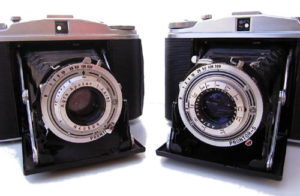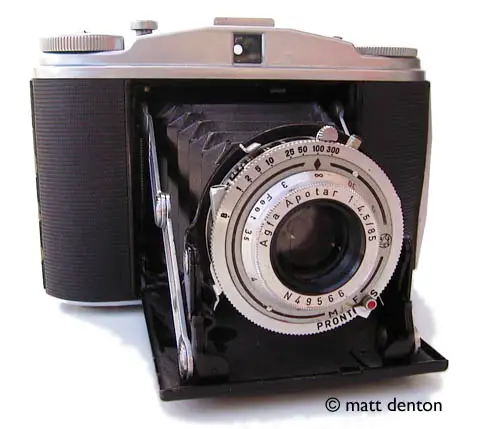- Produced c1950-c1960 Agfa Germany
- Film type 120
- Picture size 6×6
- Weight 1lb, 4.1oz (569.8g)
- Lens coated Apotar (3 element Apochromatic Anastigmat) 85mm f4.5
- Filter size
- Focal range 3′ to infinity
- Shutter Prontor-S
- Shutter speeds B, 1, 2, 5, 10, 25, 50, 100, 300 and switch for T
- Viewfinder simple
- Exposure meter none
Overview
Agfa’s Isolette series seems to me to be so well known that I avoided it for quite some time on the grounds that it was simply too obvious of a choice. Eventually I gave in but only on the condition that it had an Apotar instead of an Agnar lens, and at least a Prontor-S (if not SV or SVS) shutter instead of the lower-end Vario or Pronto. I finally did, and, well, it turns out to be a fun and well made compact 6×6 shooter. No wonder it’s still so popular, and why it was copied so frequently by other makers (Zeiss, Balda, Welta, Franka, etc.) And the test roll I shot tells me the lens deserves its good reputation.
The Isolette series, and its kissing cousins in the Ansco Speedex series (also made by Agfa for Ansco) had several versions. There is an original Isolette with an Agfa shutter (black front) and usually an Agnar lens; an Isolette I usually found with a limited-speed Vario shutter and and Agnar or Apotar lens, but occasionally the higher-end Solinar; this model, the II, usually found with the Apotar lens and a Prontor-S or Compur-Rapid shutter, later the Prontor-SVS. There is also a rangefinder model, the Isolette III, and then an Isolette IV and V which seem to be steps backwards after peaking at the III featurewise. Most of these have Ansco-branded equivalents in the Speedex line, though the Speedex Jr models are feature-reduced consumer-level cameras. And then there are model-year variations among the individual types…

The one on the right is a newer vintage. Note the differences in the front element surrounds, the glass coating, and the M-F switch on the older model for bulb sync vs flash sync. Both are nearly identical everywhere else except for the logo on the front, which I couldn’t really photograph. The older one says AGFA ISOLETTE, II, Made in Germany; the newer one says ISOLETTE II, Made in Germany. The older one has scale in feet, 3 feet to infinity; the newer one is in meters, 1m to infinity. Both have stops from f4.5 to f32. I don’t know if you noticed, but unlike most other 6×6 cameras I’ve run across, the focal length of this lens is 85mm instead of 75mm. Wonder if that extra distance helps the edge-to edge sharpness? Kind of like being slightly stopped down without stopping down…
The top left button opens the camera (looking from the back), the top right is the shutter release button. To close it just bend the arms in at the elbows and snap the front shut. Double exposure prevention, indicated by a red or silver dot on the top of the camera. If not wound (film or no) the shutter release is locked. Shutter cocks manually, releases with the top button like an SLR. Red window advance, with a sliding door to protect the film from fogging. Overall, pretty straightforward as folders go. The only unusual thing to me was that there’s no flip-down leg to make it stand up on its own, it’s designed to rest right on the convex and very sturdy door. Nice.
Repairs
Debris in between the lens elements, easily cleaned by removing the rear element and cleaning inside with the shutter open on B. I understand that Isolettes are commonly found with their focusing front elements frozen in place from hardened grease, this one could probably use a lube job in that area but luckily for me turns freely.
Tips & Tricks
Mmm… Like I mentioned, it’s pretty straightforward. There is a separate switch on the back of the camera for the T setting, as on its contemporary the Franka Solida III.
Related Links
- The manual! Courtesy of Richard Urmonas’ great manuals page
- Excellent English/French page on the Isolette II at Forgotten Cameras
- Roland and Caroline’s take on the Isolette II
- Ken Smith has a lovely Isolette II, featured on his nice site.
